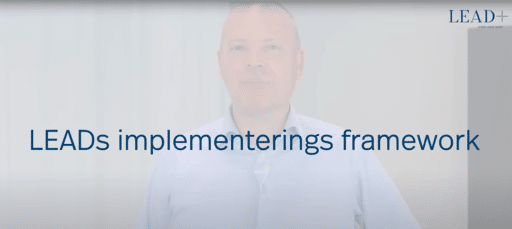Flat, leaderless, self-managing, TEAL and sociocratic. The list of new organizational forms is long. And we could go on and on. Danish organizations are increasingly experimenting with less hierarchical forms of organization and management. More and more people are trying out or want to try out new ways of organizing themselves. And we can understand that.
The potential is huge when it comes to promoting well-being and sustainable performance and creating attractive workplaces that both attract and retain talented employees. But no organizational form is perfect. There are strengths, limitations and pitfalls to the newer forms of organization that are so popular at the moment. If you want to know more about new organizational forms, we recommend you read this article: New organizational forms have overlooked potential in the fight against unhappiness.
It's important that you know these strengths, limitations and pitfalls so you don't just get caught up in the hype, but know what to look out for if you want to flatten the hierarchy in your organization. We'll help you with that in this article.
Hierarkierne flades ud og ledelse fordeles på flere personer
In recent decades, we have seen new and less hierarchical forms of organization emerging in both private and public organizations. They are often described as a response to the weaknesses of more hierarchical and bureaucratic organizations (Hamel & Zanini, 2021). The new organizational forms have many different names, terms, forms and theoretical backgrounds, but what they all have in common is a desire for flatter (and sometimes no) hierarchies and fewer formal leadership roles.
Instead, the focus is on distributing power, responsibility and mandate among individuals to create a higher degree of co-management and self-organization in task execution, but often also when it comes to direction and prioritization. The aim is to distribute responsibility and influence widely and thereby create a higher degree of connectedness and collaboration, which hopefully benefits both well-being and performance.
Many want to flatten the hierarchies, but there are many ways to get there. In general, we see two groups emerging right now. The first group is the "rebellious breakaway organizations" that are lit by the sacred fire. They take the plunge and dare to design their organization fundamentally differently. In its pure form, very few organizations go all in in this way. Clever, which sells electric mobility and electric car charging services, and JAC, a municipal job center in Gentofte Municipality, are probably the clearest examples in a Danish context right now.
The second group are the more cautious and pragmatic "both-and" organizations that stick to hierarchy but have areas, departments or parts of the organization where the hierarchy is flattened and leadership is distributed among more people. Examples include Danske Bank, the Danish Agency for Labor Market and Recruitment (STAR) and a large number of municipalities. Most Danish organizations place themselves in this "both-and" balance, seeking the best of both worlds. And there are both strengths and pitfalls associated with this. Let's take a look at them.
Focus on power, responsibility and culture when hierarchy is flattened
As new and flatter forms of organization mix with hierarchies in Danish organizations, a number of pitfalls arise that are important to keep in mind. In the following, we take a closer look at three pitfalls, namely power, responsibility and culture, which are particularly highlighted in the literature when you want to organize differently than the traditional hierarchy.
1. Management power becomes more ambiguous
In the new organizational forms, hierarchies are flattened and leadership is understood more as a process and a shared responsibility in a collective of individuals who together must coordinate, ensure common direction and create commitment. In other words, it's less about who is leading and more about how leadership is produced together. This may or may not include formal leaders (Drath et. al., 2008).
Often, formal leadership roles are not abandoned completely, but there are fewer formal leaders and leadership responsibilities are distributed among more people (Laoux, 2015). In agile organizations, for example, we see that Product Owners are responsible for the product, while the Scrum Master is responsible for the process. However, none of the alternative roles have classic formal management powers for budget responsibility and personnel responsibility (Østergaard, 2020).
In Teal organizations, we see that the responsibility for leadership is attached to the self-organized team that plans, coordinates, sets direction and shares tasks among themselves. What we see here is a tendency for leadership to become very much a relational and dialogical process in a network of connected individuals with complementary roles and responsibilities. And not a hierarchical line where the formal leader defines the goals, sets the direction and delegates tasks (Laloux, 2015). Here, formal and informal leadership roles are mixed together, which runs the risk of creating uncertainty, dissatisfaction and role conflicts if no attention is paid to how leadership and power dynamics are managed appropriately in new ways (Fogsgaard & Elmholdt, 2014).
One of the benefits of hierarchy is that structural power, understood as power through position, authority and mandate over others, is clearly distributed. Power is linked to a number of formal positions and roles in the organization that are associated with the right and duty to decide over others, which can potentially lead to organizational transparency and clarity. In the new organizational forms, structural power is much more diluted as formal leadership roles are either removed or distributed to informal leaders or the collective (Laloux, 2015).
Whether we like it or not, there will always be power in organizations, but flatter hierarchies and trends towards distributed leadership mean that structural power is becoming more blurred. And many will naturally ask themselves the question: "Who is really in charge here?". This is where personal power comes into play. Personal power is based on the individual's special characteristics, charisma and human skills to get others to follow you or do certain things - even if there is not necessarily formal authority or mandate associated with their role (Fogsgaard & Elmholdt, 2014). In practice, this means that people who have strong interpersonal skills, charisma, organizational flair or high impact will be able to influence the team or organization based on their personal power resources.
In the new organizational forms, the formal leadership roles with their structural power fade into the background, while the informal, personal power comes to the fore. This isn't bad in itself, but it requires a keen eye for whether people in connected roles are acting for their own good or whether they are actually focused on serving the team, the organization, the customer and the good of society. It can also create power struggles within the team as interpersonal skills, followership and personal power resources can become more important than professional perspectives (Fogsgaard & Elmholdt, 2014).
We highlight the understanding of leadership and power in new organizational forms because the flatter hierarchies and distributed mandate shifts power and the classic understanding of leadership, followership and common goals. If we don't keep this in mind, new organizational forms can end up doing more harm than good for both well-being and performance.
2. Responsibility is widely shared - but do we want the responsibility?
A basic premise of the new organizational forms is that responsibility is distributed and pushed out more widely in the organization. Management becomes a shared task, but it also means that the responsibility for direction, prioritization and task execution is shared collectively within the team. This creates two fundamental questions: "Do we want this responsibility - and what happens if we fail to manage it properly?".
Participation, involvement and responsibility are considered positive factors in a good psychological work environment, but so is the balance between demands and control. The liberating potential of the new forms of organization can have the downside that (too) much is left to the individual or team. This liberation can potentially accelerate boundary-less work, where you never know when you have succeeded because there is no external, managerial assessment (Andersen & Kingston, 2016). If you are not able to define a good balance yourself (in collaboration with colleagues), self-defined and thus potentially boundaryless work can be just as challenging as having a narrow framework and minimal influence at work (Andersen & Kingston, 2016).
It is therefore important to be aware of when responsibility and influence become "too much of a good thing". If opportunities for influence and autonomy are not managed properly, they can overflow and become risk factors because they impose too much work or responsibility on the individual or team, which can instead create dissatisfaction (Klitgaard & Clausen, 2010).
It's also important to emphasize that there are big individual differences when it comes to taking responsibility - and being accountable for your own decisions. Some thrive with a high degree of responsibility, while others are more comfortable with the responsibility lying elsewhere than with themselves. This is an important point that is often overlooked in the literature on new organizational forms. It therefore becomes an independent point that the new organizational forms very much call for open conversations about responsibility, mandate and decisions, so that the individual or team is not left to their own devices with these considerations (Østergaard, 2020). Not everyone wants responsibility - and there must be room for that too. Last but not least, it's important to create clarity about the possible consequences of taking on more responsibility.
The open and inclusive possibilities that underpin the new organizational forms can have the downside of making it difficult to assign responsibility when things don't go as planned. When the clear management hierarchy is washed out, it also becomes more unclear where the ultimate responsibility lies and what the consequences are for those involved when things don't go as planned. If not handled properly, this can create a culture where no one dares to take responsibility or talk about what is difficult for fear of the consequences (Edmondson, 2019).
3. Culture and structure should go hand in hand
The new organizational forms are based on organizational and management logics that are often inverted or at least fundamentally different from traditional organizational forms. Through work and education, we are all brought up in a hierarchical world that shapes the way we think and act. It's ingrained in most of us - and is often an automatic reaction that we rarely think about (Hamel & Zanini, 2021).
If you want to succeed with the new organizational forms or variations thereof, it requires a sharp eye for the existing organizational culture - and how it can both inhibit and promote the new potentials and ambitions that you want to fulfill. It also requires an awareness of the culture you want to create and how to get there in a good way (Østergaard, 2020). New and traditional forms of organization often coexist, which can lead to a host of tensions and challenges. For example, tensions between classic waterfall models and agile ways of working where you either follow a plan or work iteratively. It can also be a preoccupation with clearly defining roles and responsibilities on the one hand, versus fluid roles and responsibilities distributed to the team on the other.
In addition to being aware of culture, it also becomes important to be aware of structure when flattening the hierarchy. This is partly because structure shapes culture, and partly because hierarchy has the inherent advantage of being easy to grasp (at least it gives the illusion of structure and overview). Structure shapes culture, so it can be a good place to start to draw the structures for the new organization, forms of collaboration and workflows. However, many people tend to focus too much on structure and forget to look at what new behaviors will help fill the structure - and thus shape and influence the culture. The latter is important in order to actually flatten the hierarchy, share leadership more and involve more people. The challenge here is that the new organizational forms are more fluid, fluid and organic, which can make them difficult to visualize, explain and understand. And failing to communicate collaboration, roles, responsibilities and expectations can be a pitfall because it can become unclear, confusing and unclear to everyone involved what to do and how.
Keep an eye on power, responsibility and culture as hierarchy flattens
If we want to succeed with the new forms of organization, we need to develop and challenge our assumptions and understandings of what leadership and organization can look like.
New forms of organization can hold great potential and will in many places be a breath of fresh air in a hierarchical world. But flattening hierarchies is not without its pitfalls. Keep an eye on the management power in your organization and make sure it works for the common good. Make sure that responsibility is distributed to those who want it - and make it clear what it means to take on responsibility. And remember to keep an eye on how structure and culture affect each other to create space for the behaviors that enable more people to be involved and share responsibility and decisions more widely across the organization.
- Andersen, M. F. & Kingston, M. (2016. Stop stress - handbook for managers. Klim. 1st edition.
- Drath, W. H, Cynthia D., McCauley, C. J., Palus, E. V.V., Patricia M.G, O'Connor, J. B. M. (2008). Direction, alignment, commitment: Toward a more integrative ontology of leadership. Leadership Quarterly.
- Edmondson, A. C. (2019)The fearless organization. Creating psychological safety in the workplace for learning, innovation, and growth. 1. Edition.
- Fogsgaard, M. & Elmholdt, C. (2014). Power in organizations. 1st edition.
- Hamel, G., & Zanini, M. (2021)Humanocracy - fight bureaucracy and empower employees. Djøf Forlag. 1st edition. 1. Oplag.
- Klitgaard, C. & Clausen, T. (2010). Mapping of positive work environment factors. The National Research Center for the Working Environment, Copenhagen, 2010.
- Laloux, F. (2015)Reinventing organizations. A Guide to Creating Organizations Inspired by the Next Stage of Human Consciousness. Nelson Parker. 1st Edition.
- Østergaard, E. H (2020)Teal dot in an orange world - how to organize the workplace of the future. Lid Publishing Limited. 1. Edition.





